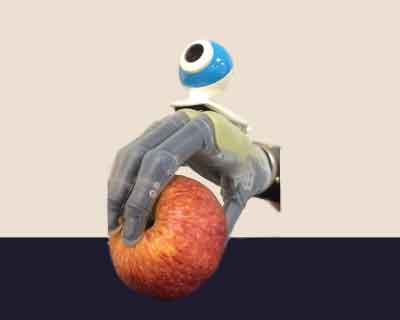- Home
- Editorial
- News
- Practice Guidelines
- Anesthesiology Guidelines
- Cancer Guidelines
- Cardiac Sciences Guidelines
- Critical Care Guidelines
- Dentistry Guidelines
- Dermatology Guidelines
- Diabetes and Endo Guidelines
- Diagnostics Guidelines
- ENT Guidelines
- Featured Practice Guidelines
- Gastroenterology Guidelines
- Geriatrics Guidelines
- Medicine Guidelines
- Nephrology Guidelines
- Neurosciences Guidelines
- Obs and Gynae Guidelines
- Ophthalmology Guidelines
- Orthopaedics Guidelines
- Paediatrics Guidelines
- Psychiatry Guidelines
- Pulmonology Guidelines
- Radiology Guidelines
- Surgery Guidelines
- Urology Guidelines
Scientists develop bionic hand that sees, grasps things

London: Scientists have developed a bionic hand that 'sees' objects and allows amputees to grasp things ten times faster than current prosthetics.
The bionic hand is fitted with a camera which instantly takes a picture of an object, assesses its shape and size and triggers movements in the hand. Bypassing the usual processes which require the user to see the object, physically stimulate the muscles in the arm and trigger a movement in the prosthetic limb, the hand reacts in one fluid movement.
A small number of amputees have trialed the new technology developed by researchers at the Newcastle University in the UK.
"Prosthetic limbs have changed very little in the past 100 years. They are more light weight and durable but still work the same way," said Kianoush Nazarpour, from the university.
"We have developed a bionic hand which can respond automatically. Just like a real hand, the user can pick up a cup or a biscuit with nothing more than a quick glance," said Nazarpour.
"Responsiveness has been one of the main barriers to artificial limbs. For many amputees the reference point is their healthy arm or leg so prosthetics seem slow in comparison," he said. "Now, for the first time, we have developed an 'intuitive' hand that can react without thinking," he added.
Current prosthetic hands are controlled via electrical activity of the muscles recorded from the skin surface. Controlling them takes practice, concentration and time. Using neural networks -- the basis for artificial intelligence -- researchers showed the computer numerous object images and taught it to recognise the 'grip' needed for different objects.
"We would show the computer a picture of, for example, a stick from different angles and orientations, in different lights and against different backgrounds and eventually the computer learns what grasp it needs to pick that stick up," said Ghazal Ghazaei, from Newcastle University.
Using the camera fitted to the prosthesis, the hand 'sees' an object, picks the most appropriate grasp and sends a signal to the hand in milliseconds -- ten times faster than any limb on the market. The study was published in the Journal of Neural Engineering.

Disclaimer: This site is primarily intended for healthcare professionals. Any content/information on this website does not replace the advice of medical and/or health professionals and should not be construed as medical/diagnostic advice/endorsement or prescription. Use of this site is subject to our terms of use, privacy policy, advertisement policy. © 2020 Minerva Medical Treatment Pvt Ltd